Apr 26, 2024
Apr 26, 2024
by Sunanda Nair
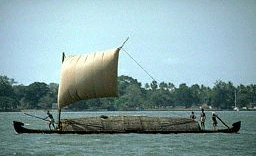 This Indian classical dance form - Mohiniattam - comes from one of the southern states of India, Kerala. And the mere mention of Kerala brings up in one's mind the wondrous and incomparable beauty of its landscape. The scenic backwaters where the palm fronds fill up the Kerala skyline moving gently and gracefully in the breeze, the boats bobbing up and down gently, gracefully and in perfect tune with nature and its rhythm.
This Indian classical dance form - Mohiniattam - comes from one of the southern states of India, Kerala. And the mere mention of Kerala brings up in one's mind the wondrous and incomparable beauty of its landscape. The scenic backwaters where the palm fronds fill up the Kerala skyline moving gently and gracefully in the breeze, the boats bobbing up and down gently, gracefully and in perfect tune with nature and its rhythm.
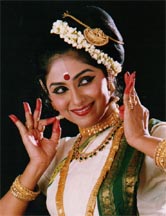 A Mohini Attam dancer immediately reminds you of this scenic beauty in her dance. The movements are beautiful and lyrical and they are always in an unbroken chain, from one movement very gently and gracefully merging into another. Though the movements are swaying and gentle the presentation comes out with a tremendous and strong impact leaving the spectator in an atmosphere of grace, charm, vitality and a forceful vivacity. The graceful and long limbs of a Mohini Attam dancer brings before your eyes the vision of the palm fronds swaying and dancing in the breeze and the movements are like those of a boat bobbing up and down in the back waters. There is a tremendous amount of force that a Mohini Attam dancer brings out in her performance without which the performance would be lacking in its luster but this tremendous energy is released in a very controlled and graceful manner which can be achieved only with discipline, hard work and (Bhakti) or devotion to the art form.
A Mohini Attam dancer immediately reminds you of this scenic beauty in her dance. The movements are beautiful and lyrical and they are always in an unbroken chain, from one movement very gently and gracefully merging into another. Though the movements are swaying and gentle the presentation comes out with a tremendous and strong impact leaving the spectator in an atmosphere of grace, charm, vitality and a forceful vivacity. The graceful and long limbs of a Mohini Attam dancer brings before your eyes the vision of the palm fronds swaying and dancing in the breeze and the movements are like those of a boat bobbing up and down in the back waters. There is a tremendous amount of force that a Mohini Attam dancer brings out in her performance without which the performance would be lacking in its luster but this tremendous energy is released in a very controlled and graceful manner which can be achieved only with discipline, hard work and (Bhakti) or devotion to the art form.
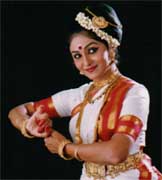 Also, another feature that influences Mohini Attam is the simplicity of dressing by the people in Kerala which is visible in the costume of the dancer. White is a favorite color of the people basically because of the hot and humid climate, and a Mohini Attam costume is always white or off white with gold or red border. The hair is tied in a bundle on the left side with white flowers (Mogra) around it, with a simple ornament tied on the bun. The jewelry used for the neck is a 'choker', and a kasimala (coin chain). For the ears a dancer wears a 'toda' which is circular like a coin and has dangling earrings with it known as'jhumka'. The face is done up with an exaggerated eye make up to help her express her emotions. The eyes reflect immediately the mental state of the situation or character the dancer is representing and a description of Mohini Attam cannot be complete without the mention of the Nayan-Abhinaya or the use of the eyes, eyebrows and eyelids.
Also, another feature that influences Mohini Attam is the simplicity of dressing by the people in Kerala which is visible in the costume of the dancer. White is a favorite color of the people basically because of the hot and humid climate, and a Mohini Attam costume is always white or off white with gold or red border. The hair is tied in a bundle on the left side with white flowers (Mogra) around it, with a simple ornament tied on the bun. The jewelry used for the neck is a 'choker', and a kasimala (coin chain). For the ears a dancer wears a 'toda' which is circular like a coin and has dangling earrings with it known as'jhumka'. The face is done up with an exaggerated eye make up to help her express her emotions. The eyes reflect immediately the mental state of the situation or character the dancer is representing and a description of Mohini Attam cannot be complete without the mention of the Nayan-Abhinaya or the use of the eyes, eyebrows and eyelids.
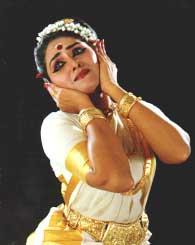 The tinkling sound of bells, the sweet smell of flowers, the divine being, the beauty unparalleled - The Enchantress. The one, who could take your minds away from the present to another world of beauty and charm. The lotus eyed one dancing gently and gracefully filling the atmosphere with unsurpassed heavenly beauty. The demons true to her instructions shut their eyes to relinquish and behold the beauty they envisioned. She is Mohini the celestial dancer, one who has come to enchant.
The tinkling sound of bells, the sweet smell of flowers, the divine being, the beauty unparalleled - The Enchantress. The one, who could take your minds away from the present to another world of beauty and charm. The lotus eyed one dancing gently and gracefully filling the atmosphere with unsurpassed heavenly beauty. The demons true to her instructions shut their eyes to relinquish and behold the beauty they envisioned. She is Mohini the celestial dancer, one who has come to enchant.
Until, a few decades ago it was presumed that in India there were only four classical dances. Bharata Natyam, Kathak, Manipuri and Kathakali . But then due to the pioneering works of great gurus (teachers), dancers and scholars the dance forms of Mohini Attam, Kuchipudi and Odissi were discovered in their native settings and brought out into the urban stage, much to the delight and wonderment of the lovers of dance.
There is a considerable amount of disagreement among scholars regarding the antiquity of Mohini Attam. Most of them agree that it was during Maharaja Swati Tirunal's rule in the 16th century that Mohini Attam achieved its refined form. The Maharaja of Travancore was a great patron of arts and he encouraged artistes, singers, dancers from all over the country to come and perform in his court. During this time he also invited the Tanjore quartets from Tamil Nadu who were great Bharata Natyam nattuvanars (or teachers) who brought with them dancers and thus influenced the already present local dance form. The Maharaja was a great bhakta or devotee of Lord Padmanabha and wrote and composed in Hindustani as well as Carnatic innumerable kritis, padams and varnams in his praise. The Maharaja's padams are always a part of a Mohini Attam dancer's repertoire.
But it was finally only in the 20th century that Mohini Attam got its fresh impetus that it actually deserved, and it has come to stay. It was when Mahakavi Vallathol set up the premiere institution for Kathakali , Kerala Kalamandalam in India that he invited three dancers practicing Mohini Attam at that time Kalpuratte Kunjukutty Amma, Tottacheri Chinnamuamma and Kalyani Kutty Amma to come and teach Mohini Attam in his institution. Till, little more than a decade ago the Mohini Attam repertoire ran almost parallel to the Bharata Natyam repertoire. But just as each region has its own individuality and identity it was natural that Mohini Attam had to find its own identity. Due to the relentless work of great researchers, scholars, performers of Mohini Attam, this dance form achieved its present classical standing.
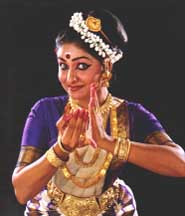 Today, we have different schools of Mohini Attam just as you have schools for Bharata Natyam. But they all have one thing in common they all imbibe the beautiful lyrical elements of the social folk dances of the graceful women from Kerala. Every classical dance form from India has its beginnings in the local prevalent folk art forms and has also been very strongly influenced by the social, political, religious and behavioral pattern of the people of the region. The classical dance forms have imbibed these features to give them all a distinct flavor of its own, but they are still all bound by the great traditions set by the 'Natyashastra' around the 2nd century B.C.
Today, we have different schools of Mohini Attam just as you have schools for Bharata Natyam. But they all have one thing in common they all imbibe the beautiful lyrical elements of the social folk dances of the graceful women from Kerala. Every classical dance form from India has its beginnings in the local prevalent folk art forms and has also been very strongly influenced by the social, political, religious and behavioral pattern of the people of the region. The classical dance forms have imbibed these features to give them all a distinct flavor of its own, but they are still all bound by the great traditions set by the 'Natyashastra' around the 2nd century B.C.
The 'Natyashastra' is a treatise on dance and drama and lays down rules regarding the practice and presentation of drama and dance. Each dance form adopts it to suit the regional changes in the social, religious, political and behavior of the people. But it was around the 3rd century AD that Nandikeshvara wrote the Abhinaya Darpanam which is very religiously followed by the practitioners of Bharata Natyam. It gives the usage of hastas (hand gestures), pada bhedas (feet positions),caris (gaits), gatis (stepping) etc.
Similarly a study of Mohini Attam wouldn't be complete without the study ofBalaramabharatam. The author Maharaja Kartikatirunal Rama Varma was a descendant of the ancient Chera kings of South India who encouraged arts and literature in the 18th century. The Maharaja was a great scholar and had an extraordinary talents not only for literature but also for music, dance and other allied arts and was also a great poet. His contribution to Kathakali (a dance drama tradition) of Kerala is incomparable. The book gives a detailed insight into the technical performing aspects for Mohini Attam. There is a mention of the use ofhastas (hand gestures), angas (major limbs) upangas (minor limbs ) andpratyangas (neck, wrists, knees, thighs etc). Reading through the text and the practical details mentioned in the book leaves a student of Mohini Attam with very few doubts on the technicalities. The Balaramabharatam is an accepted text by most leading dancers, scholars of India today for Mohini Attam.
Being associated for a very long time and having the opportunity to learn under one of the pioneers of Mohini Attam, Padmashri (Dr.) Kanak Rele who is responsible for bringing Mohini Attam into the classical map of India, I would say is a blessing. Also the privilege of working with one of the leading theater personalities, scholar, poet and a great musical composer Shri Kavalam Narayana Panikker whose contribution to Mohini Attam also needs a special mention. Mohini Attam will flourish and go a long way. With due respect to all performers, scholars, and teachers of the art form, we shall have just one aim in mind to carry on this great art form from one century into the next. The responsibility put into us by the great performers of the last and present century to carry on this great tradition and initiate the uninitiated into another world of beauty, grace and charm.
Vastly gifted with an attractive demeanor suitable for this form of dancing, Sunanda indeed casts a spell on her onlookers while performing. She exudes vitality, warmth and endows her dance with an added dimension, and she enchants the initiated and the uninitiated alike. It is her ability to infuse beauty in whatever she creates and give joyousness to her movements and expressions that set her apart from other practitioners. The movements are full of life and endowed with sensitive lyricism. Sunanda is the disciple of the noted Mohini Attam exponent Padmashree Dr. (Smt) Kanak Rele, who is renowned for her contribution to the revival and popularization of this classical dance style. She has the proud privilege of being the first student to earn a Master's degree in Mohini Attam from Nalanda Nritya Kala Mahavidyalay affiliated to the University of Mumbai. Sunanda has prepared for her vocation both as a professional dancer and a teacher of dance, through rich and multifaceted experiences in higher academics, stage performances, classroom instruction and choreography.
31-Mar-2001
More by : Sunanda Nair